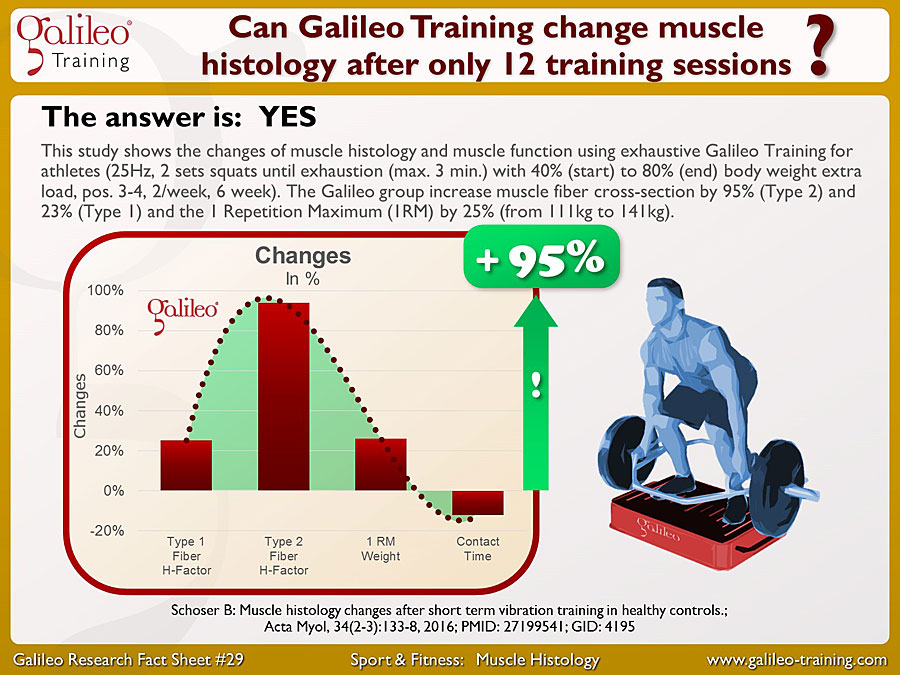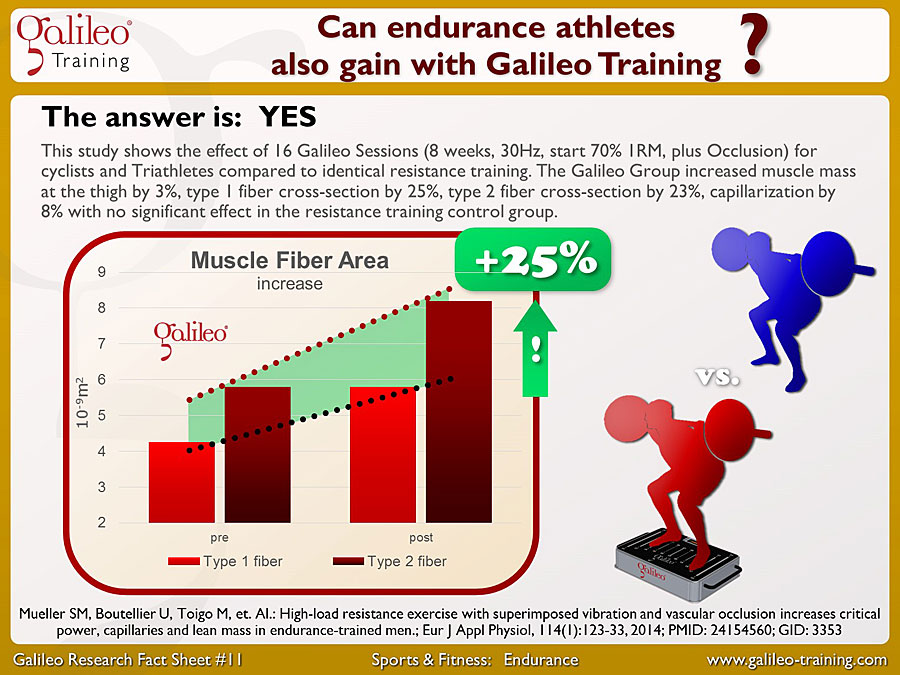The first Whole Body Vibration Training study ever, done with Galileo in 1998. It shows the effects of Galileo Training on Jumping performance in active handball and water polo players (26Hz, pos. 5, 5*2 min., 10 days, 1) forefoot 2) 45° squat 3) 90°squat 4/5) 90°squat one legged). Both groups performed additional 20 min. warmup and 5 min. jump training. Only the Galileo Training group showed jump improvements of up to 12%...
This study reports short-term effects of Galileo Training on skin blood-flow and blood Nitirc Oxide (NO) concentration as an indicator for intense muscle work (10*30 sec., 26Hz, pos. 2, 35° bent knees). The Galileo group showed significant higher effects than the control group. In addition it was observed that skin blood flow was highest during training but NO concentration was increased massively 5 minutes after the training...
This study shows the changes of muscle histology and muscle function using exhaustive Galileo Training for athletes (25Hz, 2 sets squats until exhaustion (max. 3 min.) with 40% (start) to 80% (end) body weight extra load, pos. 3-4, 2/week, 6 week). The Galileo group increase muscle fiber cross-section by 95% (Type 2) and 23% (Type 1) and the 1 Repetition Maximum (1RM) by 25% (from 111kg to 141kg)...
This study used Galileo Training in rest phases between High Intensity Training (HIT) intervals to reduce loss of anaerobic power (20 Sessions HIT, HIT+18Hz/HIT+30Hz, 3 min., pos. 3, knees half bent). Galileo Training during rest phases could compensate the HIT associated loss of anaerobic power and MyHC-2x fiber cross-sectional area completely. Galileo Training at 18 Hz showed about 20% higher effects than training at 30Hz...
This study tested the immediate effect of Galileo Training on one-legged leg-press performance (only 1 leg on Galileo, other leg as control, 10x1 min., 1. min. rest, 26Hz, pos. 4, one-legged on toes, knee angle 100°-110°). Comparison between trained and untrained leg immediately before and after the training. The Galileo Training leg improved velocity and power in the leg-press exercise almost independent of extra loads by almost 10%. ..
This study shows the effect of 16 Galileo Sessions (8 weeks, 30Hz, start 60% body weight, plus Occlusion) fro a group of young women compared to identical resistance training without vibration. The Galileo group increased the resistance by 85%, endurance by 57%, peak power on the ergometer by 9% (Wingate Rest); The resistance control group did not show a significant positive effect...
This study shows the effect of 16 Galileo Sessions (8 weeks, 30Hz, start 70% 1RM, plus Occlusion) for cyclists and Triathletes compared to identical resistance training. The Galileo Group increased muscle mass at the thigh by 3%, type 1 fiber cross-section by 25%, type 2 fiber cross-section by 23%, capillarization by 8% with no significant effect in the resistance training control group...
Diese Studie untersucht den Einfluss von Galileo Training auf Muskelkater. Beide Gruppen trainierten exzentrische Quadrizeps Extension bei 120% 1RM. Die Galileo Gruppe trainierte anschließend 3 Min. mit Galileo bei 12Hz. Galileo Training halbierte den subjektiven Muskelkater und reduzierte die Creatin-Kinase-Werte (CK) um 40%...
This study investigates the influence of Galileo Training on muscle soreness. Both groups trained eccentric quadriceps extension at 120% 1RM. The Galileo group then trained for 3 minutes with Galileo at 12Hz. Galileo Training halved the subjective muscle soreness...








